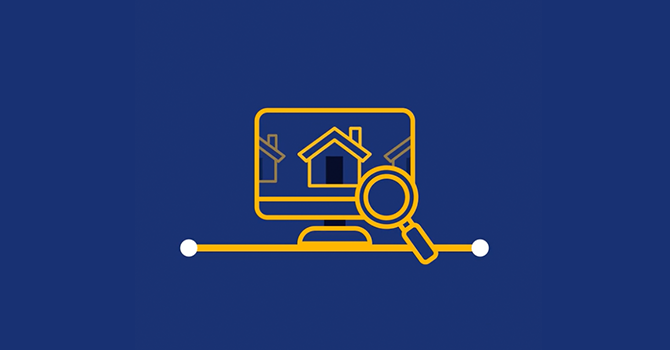Now that you’ve been in your home for a while, you may want to consider refinancing your mortgage. Whether you’re just exploring the idea or ready to start the process, this guide will help you make the right decisions for you and your family.
Start with your goals
First, it helps to start the process with a clear goal in mind. Consider the following questions to get clear on what you hope to achieve through refinancing:
- Are you looking to shorten the term of your loan? If you have a 30-year mortgage that you want to pay off before retirement, for example, look for a 20-, 15-, or 10-year loan.
- Do you want to save money over the life of the loan? Consider paying points to get a lower rate, especially if you plan to stay in your home for a number of years. Our smart, simple, and secure mortgage refinancing application provides customized options based on your goals. Check it out at laurelroad.com/mortgage.
- Do you need to lower your monthly payment? You could look to refinance to a lower interest rate and/or extend the term of your loan.
- Do you have an adjustable-rate mortgage (ARM) and are concerned about rising interest rates? You could convert your ARM to a fixed-rate loan.
- Are you looking to get rid of private mortgage insurance (PMI)? You could refinance to reduce your loan-to value ratio (the amount you want to borrow divided by the home’s current value).
- Do you want to cash out some of the equity you’ve built up in your home? Consider a cash-out refinance, where the new mortgage is for a larger amount than your current loan, and you get the difference in cash.
Our smart, simple, and secure mortgage refinancing application provides customized options based on your goals. Check it out at laurelroad.com/mortgage.
Understand the costs and risks
There can be fees and risks associated with refinancing. Take them into account when weighing your options, and consider the following:
- Some mortgages have a pre-payment penalty. Don’t automatically dismiss refinancing if your current mortgage has a pre-payment penalty, but factor it in when crunching the numbers.
- Don’t overestimate the current value of your home. The appraised value could come in lower than anticipated, which will affect the amount of equity you have in your home.
- Mortgage loans front-load interest. For a typical 30-year mortgage, interest is front-loaded. This means during the earlier part of your mortgage term, the majority of your payments will go towards interest rather than principal. However, you may consider refinancing to a shorter term to build equity faster.
- If you’re planning to sell your home in the near future, it may not make sense to refinance. Calculate how long it’ll take you to recover your refinancing costs and plan to stay in your home for at least that long.
Refinancing step-by-step
Follow these steps to start the refinancing process.
1. Get your current credit score and calculate your DTI.
Your credit score affects the interest rates you’ll be offered, so check your current credit report. If there are issues with your credit score, address them before talking with lenders. Your debt-to-income ratio (DTI) is the monthly minimum payments on credit cards and other loans, divided by your monthly income. The lower the number the better, and most lenders usually look for a DTI of 43% or less. Get your annual free credit report at: AnnualCreditReport.com
Debt-to-Income Calculator

Add your information to the left to calculate.
2. Research your home’s current value
Lenders also look at is how much equity you have in your home. Equity is determined based on the current value of the home, not the price you originally paid for it. Review real estate websites for estimates of your home’s value and recent sale prices of comparable properties in the area. You’ll likely need to get an appraisal done, but this early research helps you see where you stand.
3. Research mortgage rates
A refinance calculator will give you an idea of how much your new mortgage will cost. Look at both the monthly payment and the total cost over the full term of the mortgage. Then you’re ready to start getting quotes, but it’s important to understand how to navigate lender promotions – not all rates that are promoted may be available to you. And while there are “no closing cost” options, such programs typically roll those costs into the interest rate. While that might seem a small increase, it can add up over the life of the loan. Use our free online application to check your rates and see how much you could save: laurelroad.com/mortgage
4. Understand your all-in costs
Your lender will provide an initial loan estimate, which includes a breakdown of all the potential costs associated with your loan. A final closing disclosure will be issued three days prior to the closing
5. Gather Your Paperwork
While requirements for personal and financial information can vary depending on your lender, there are some documents that you’ll probably need to provide to secure your loan. Be sure you check with your lender for any specific requirements. Here is a general checklist to get started.
- Personal information. Your social security number and date of birth.
- Information about your house. Homeowner’s insurance, etc.
- Information about your current mortgage. Your current mortgage statement will provide the lender with the following information: current rate, monthly payment, outstanding balance, due date, escrows, and any mortgage insurance premiums.
- Employment information. Names, addresses, and telephone numbers of your employers from the past two years. If you’re self-employed, you’ll need profit and loss statements and federal tax returns for the past two years.
- Financial information. For most clients, W2s and paystubs are typically sufficient. Self-employed clients may need to provide additional documents such as personal and business tax returns. If you need funds to close or financial reserves to qualify, you may need to provide information on checking, savings, and/or other investment and retirement accounts.
Note: You are not required to provide a lender any verifying documentation until after you have received a Loan Estimate.
6. Lock in your rate
Rate locks can last anywhere from 30 to 60 days. A longer rate lock typically involves a slightly higher interest rate.
7. Get ready to close
Once your loan has been cleared to close, you will receive your Closing Disclosure. This document will provide terms and costs associated with your loan request. It will also detail your funds needed to close or the total amount of cash back you will receive after funding.
As a national lender, Laurel Road helps determined buyers work smarter by providing personalized mortgage options at real, competitive rates. Our secure technology builds mortgages online, simplifying the process with clear options, transparent fees, and human support when you need it.
To learn more and refinance your mortgage online visit laurelroad.com/mortgage







